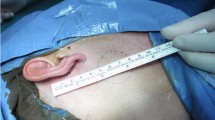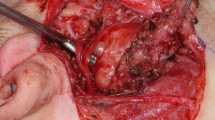Abstract
The results indicate that the modified cervicofacial incision is a better aesthetic option for surgical procedures concerning all benign and malignant neoplasms of the parotid gland. The aim of this study was to present the results of the use of modification of modified Bailey incision in Parotid Surgery. This is a case series comprising 155 consecutive patients who were subjected to either partial or total parotidectomy using the modified incision. All parotid tumors were removed without encountering any problem with exposure, facial nerve delineation or tumor delivery. There was no need for any further extension of the skin incision and all the patients had a good aesthetic result.
Similar content being viewed by others
Avoid common mistakes on your manuscript.
Introduction
Parotidectomy is a very common surgical procedure which is performed on benign or malignant neoplasms of parotid. The main aim of surgery is complete removal of the mass with preservation of the facial nerve. The most commonly used incision for parotidectomies is the cervicomastoid facial incision described by Blair in 1912 and modified by Bailey in 1941 [1]. It consists of a preauricular approach together with submandibular or cervical extension. The aim of this study is to highlight a modified cervicofacial incision for Parotidectomy that leaves no obvious scarring without compromising exposure for tumor removal.
Materials and Methods
155 consecutive patients with male to female ratio of 1.5:1 who underwent superficial or total Parotidectomy between 2006 and 2014 were included in the analysis. Indications for parotidectomy included pleomorphic adenoma (n = 106) and malignant tumors of the Parotid gland (n = 49). The patients included 93 men and 62 women with a mean age of 44 years
The incision began in the preauricular crease, continued vertically down into along the tragus and then instead of turning it retroauricularly over the mastoid process around the earlobe, it was extended directly downwards approximately 3 cm below the ramus of the mandible (Figs. 1, 2). The skin flap was raised all around to get proper exposure of the tumor in the Parotid gland (Fig. 3). After performing the Parotidectomy and careful hemostasis, the skin wound was closed in two layers. The Radivac (negative suction drain) was used in all the cases. The drain was removed when the drainage was less than 25 ml and patient discharged afterwards from the hospital. All the patients were asked to follow up in the Head and Neck clinic over a period ranging from 6 months to 4 years. The patients were examined to look for the aesthetic results of the incision, complications and assess for any tumor recurrences.
Results
The follow up data was available for 121 patients. The patients were asked to grade the aesthetic appearance of the incision by grading them from 1 to 10 based on Visual analogue scale. The score up to 4 was considered as fair, a score from 4 to 7 was graded as good and a score more than 7 was considered as excellent. Majority of the patients graded the aesthetic appearance as good and excellent.
The tumors were removed in all the cases with no need for further skin extension. The patients presented good overall postoperative follow-up. The incisions showed highly satisfactory aesthetic results and only imperceptible scar could be seen after 6 months of the surgery (Fig. 4). No case of local wound infection, wound dehiscence or blackening was seen. All patients reported satisfaction with result of the operation.
Discussion
The search for minimally invasive approaches and/or minimally perceptive scars is present in every domain of surgery. With the same thing in mind, we planned this modification in the existing widely used Parotid incision and have named it as Panda’s incision. Majority of the Surgeons perform Parotidectomy through the modified Blair incision [2, 3]. Terris et al. [4] also described a modified facelift incision with similar complications. Both incisions commence as preauricular incision coursing underneath the ear lobe to the mastoid tip. The facelift incision is technically demanding as access to the Parotid gland may be difficult (Fig. 5). The modified Blair incisions most of the times leads to blackening of curve around ear lobule without any added advantage of exposure for tumour removal. This has been observed when this incision was being frequently used in the Department earlier. The modification of the standard incision employed by us has certain advantages. As there is no extra curvature in this incision, the healing is excellent. Additionally the tumor access is also direct after the flap elevation. The blood supply of the flap is uniformly maintained as there is no curvature. On reviewing the literature, we have not come across any modification of the Blair incision as has been suggested by us.
Conclusion
The modified incision provides an excellent exposure of the Parotid tumor without jeopardizing the vascularity of the flap. This unique incision gives highly esthetic results, excellent exposure of the tumor and facial nerve delineation and should be used in all Parotid surgical procedures.
References
Bailey H (1941) The tumors of the parotid gland with special reference to total parotidectomy. Br J Surg 28:337–346
Upile T, Jerjes WK, Nouraei SA, Grant W, Singh S, Sudhoff H et al (2010) Further anatomical approaches to parotid surgery. Eur Arch Otorhinolaryngol 267(5):793–800
Appiani E, Delfino MC (1984) Plastic incision for facial and neck tumors. Ann Plast Surg 13(4):335–352
Terris JD, Tuffo KM, Fee WE (1994) Modified facelift incision for parotidectomy. J Laryngol Otol 108:574–578
Author information
Authors and Affiliations
Corresponding author
Ethics declarations
Conflict of interest
All the authors declare that there is no conflict of interest.
Rights and permissions
About this article
Cite this article
Panda, N.K., Kaushal, D. & Verma, R. Do we Need to Modify the Parotidectomy Incision?. Indian J Otolaryngol Head Neck Surg 68, 487–489 (2016). https://doi.org/10.1007/s12070-016-0999-8
Received:
Accepted:
Published:
Issue Date:
DOI: https://doi.org/10.1007/s12070-016-0999-8









